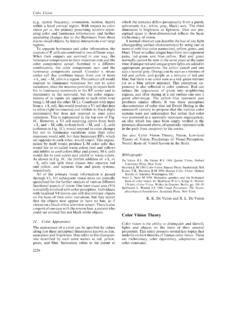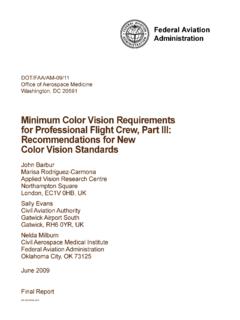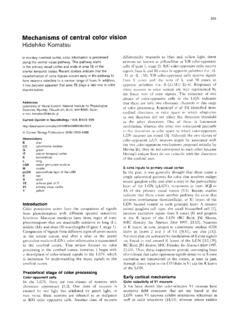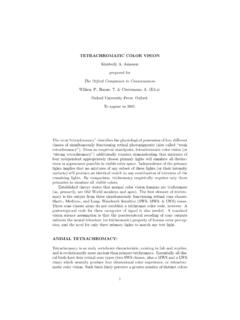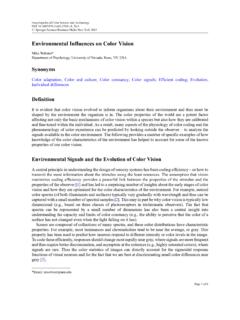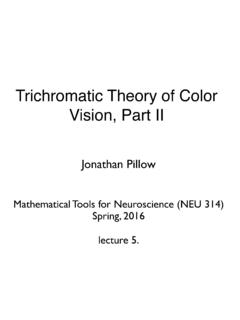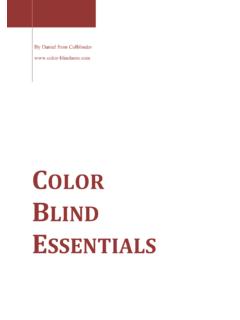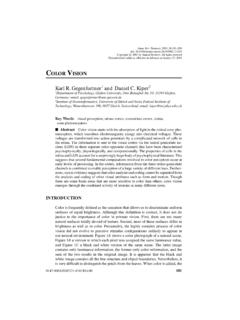Transcription of COLOR VISION MECHANISMS - David Brainard Lab
1 COLOR VISION MECHANISMSA ndrew StockmanDepartment of Visual NeuroscienceUCL Institute of OpthalmologyLondon, United KIngdom David H. BrainardDepartment of Psychology University of Pennsylvania Philadelphia, GLOSSARYA chromatic mechanism. Hypothetical psychophysical MECHANISMS , sometimes equated with the luminance mechanism, which respond primarily to changes in intensity. Note that achromatic mech-anisms may have spectrally opponent inputs, in addition to their primary nonopponent cke hue shift. The shift in the hue of a stimulus toward either the yellow or blue invariant hues with increasing mechanism. A mechanism, the response of which has two mutually exclusive types of out-put that depend on the balance between its two opposing inputs. Its response is nulled when its two inputs are A perceptual measure of the apparent intensity of lights.
2 Distinct from luminance in the sense that lights that appear equally bright are not necessarily of equal directions. Stimulus directions in a three-dimensional COLOR space that silence two of the three cardinal MECHANISMS . These are the isolating directions for the L+M, L M, and S (L+M) mech-anisms. Note that the isolating directions do not necessarily correspond to mechanism MECHANISMS . The second-site bipolar L M and S (L+M) chromatic MECHANISMS and the L+M luminance discrimination. Discrimination of a chromatic target from another target or back-ground, typically measured at mechanism. Hypothetical psychophysical MECHANISMS that respond to chromatic stimuli, that is, to stimuli modulated at appearance. Subjective appearance of the hue, brightness, and saturation of objects or MECHANISMS . Hypothetical psychophysical MECHANISMS that mediate COLOR appearance, especially as determined in hue scaling or COLOR valence assimilation.
3 The phenomenon in which the hue of an area is perceived to be closer to that of the surround than to its hue when viewed in isolation. Also known as the von Bezold spreading 6:49:49 PM8/21/09 6:49:49 VISION AND VISION OPTICSC olor constancy. The tendency of objects to retain their COLOR appearance despite changes in the spectral characteristics of the illuminant, or, more generally, despite changes in viewing contrast. The change in the COLOR appearance of an area caused by the presence of a colored surround. The COLOR change, unlike assimilation, is usually complementary to the surround MECHANISMS . Hypothetical psychophysical MECHANISMS that determine performance in chromatic detection or discrimination tasks. Assumed in some models to correspond to cone-opponent spaces. Representations of lights either in terms of the responses of some known or hypothetical MECHANISMS thought to underlie the perception of COLOR (such as cone or postreceptoral MECHANISMS ), or in terms of the projection of the lights onto stimulus-based vectors (such as mono-chromatic primaries or mechanism-isolating vectors).
4 COLOR valence. A measure of the COLOR of a light in terms of the amount of a cancelling light required to null one of the hue sensations produced by that light. Thus, if a light appears red it is can-celled by light that appears green, and the amount of this green light is its red valance. In opponent-colors theory, COLOR appearance depends on the relative red-green and blue-yellow contrast. The contrast (or relative change in quantal or energy catch) presented to each cone photoreceptor: L/L, M/M, and contrast space. A COLOR space where the position along each axis represents the contrast of one cone MECHANISMS . Hypothetical psychophysical MECHANISMS , the performances of which are limited at the cone mechanism. Hypothetical psychophysical MECHANISMS with opposed cone Krauskopf Lennie (DKL) space. COLOR space, the axes of which are the stimulus strengths in each of the three cardinal mechanism directions.
5 Closely related to the spaces proposed by L ther85 and MacLeod and In some accounts of this space the axes are defi ned in a different way, in terms of the three vectors that isolate each of the three cardinal surface or contour. Detection thresholds measured in many directions in COLOR space form a detection surface. Confi ned to a plane, they form a contour. The terms threshold surface and threshold contour are synonymous with detection surface and detection contour, method. A method in which the observer s sensitivity for detecting or discriminating a target is measured as a function of some change in context or in the adapted state of the mechanism of adaptation. Adaptation, usually assumed to be cone-class specifi c, occurring at or related to the photoreceptor Loss of sensitivity caused by prolonged adaptation to chromatic and/or achromatic stimulus modulations, also known as contrast cone-excitation space.
6 A COLOR space in which the axes represent the deviations of each of the three classes of cones from a background. Deviations can be negative (decrements) as well as Generic term to denote variation in stimulus or modulation strength when chromatic properties are held constant. In the particular context of modulations around a background, the vec-tor length of a modulation may be used as a measure of hue. A stimulus produces an invariant hue if that hue is independent of changes to stimu-lus intensity. Generally studied in the context of monochromatic direction. Direction in a COLOR space that isolates the response of a single visual MECHANISMS . Hypothetical MECHANISMS that behave linearly, usually with respect to the cone isomerization rates, but in some models with respect to the cone outputs after von Kries adaptation or contrast A measure of the effi ciency (or effectiveness) of lights often linked to the assumed output of the achromatic 6:49:50 PM8/21/09 6:49:50 PMCOLOR VISION MECHANISMS direction.
7 Stimulus COLOR direction along which a specifi ed mechanism is most sensi-tive. Note that the mechanism direction is not, in general, the same as the isolating direction for the same masking. Threshold elevations caused by superimposing targets in visual MECHANISMS . Hypothetical MECHANISMS that behave nonlinearly either with re-spect to the cone inputs or with respect to their own (assumed) theory. A COLOR theory that accounts for COLOR appearance in the terms of the per-ceptual opposition of red and green (R/G), blue and yellow (B/Y), and dark and light (W/B).Pedestal effects. Changes in sensitivity that occur when a target is superimposed on another stimu-lus, called the pedestal, which may have either identical or different spatio-chromatic-temporal char-acteristics to the desensitization. Adaptation or sensitivity losses that act on the outputs of second-site cone-opponent and achromatic MECHANISMS , and thus on the combined cone signals processed by each method.
8 A method in which the sensitivity for detecting or discriminating a target is measured as a function of some target parameter, such as wavelength, size, or temporal surface or contour. Synonyms for detection surface or hues. Hues that appear perceptually unmixed, such as unique blue and unique yellow (which appear neither red nor green).Unipolar mechanism. A mechanism that responds to only one pole of bipolar cone-opponent ex-cursions, thought to be produced by half-wave rectifi cation of bipolar mechanism. A mechanism, in which the output varies unidimensionally, irrespective of the characteristics of its Bezold spreading. See COLOR Kries adaptation. Reciprocal sensitivity adjustment in response to changing light levels assumed to occur independently within each of the three cone s law. I/I = constant. The sensitivity to increments ( I) is inversely proportional to the adaptation level (I).
9 INTRODUCTIONThe first stage of COLOR VISION is now well understood (see Chap. 10). When presented in the same context under photopic conditions, pairs of lights that produce the same excitations in the long-, middle-, and short-wavelength-sensitive (L-, M-, and S-) cones match each other exactly in appear-ance. Moreover, this match survives changes in context and changes in adaptation, provided that the changes are applied equally to both lights. Crucially, however, while the match survives such mani-pulations, the shared appearance of the lights does not. Substantial shifts in COLOR appearance can be caused both by changes in context and by changes in chromatic adaptation. The identity of lights matched in this way reflects univariance at the cone photoreceptor level, whereas their changed appearance reflects the complex activity of postreceptoral MECHANISMS acting on the outputs of the cone photoreceptors.
10 Figure 1 shows examples of how COLOR contrast and COLOR assimilation can affect the COLOR appearance of pairs of lights that are physically addition to affecting COLOR appearance, postreceptoral MECHANISMS play a major role in determining the discriminability of COLOR stimuli. Indeed, measurements of COLOR thresholds (detection and discrimination) are critical in guiding models of postreceptoral MECHANISMS . Models of COLOR discrimination are also important in industrial applications, for instance, in the specifica-tion tolerances for COLOR reproduction (see subsection CIE Uniform COLOR Spaces in Sec. , Chap. 10). 6:49:50 PM8/21/09 6:49:50 VISION AND VISION OPTICSC olor contrastColor assimilation(a)(b)FIGURE 1 (a) COLOR contrast: The pairs of smaller squares in each of the four vertical columns are physi-cally the same, but their COLOR appearances are very different.
